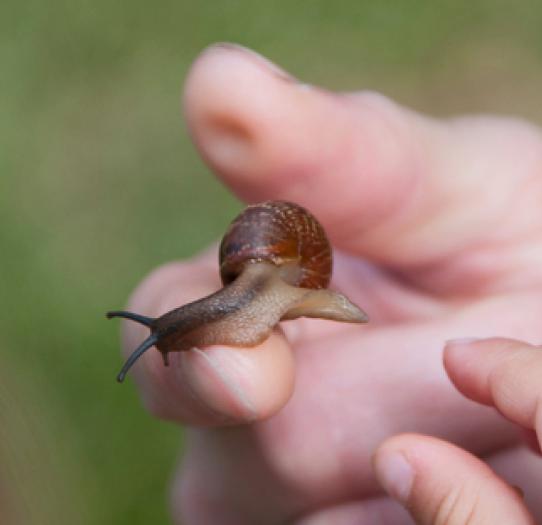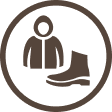A Place to Learn
Explore learning opportunities at Wild Nephin.
Wild Nephin National Park Education Centre aims to raise awareness of the natural world and dark skies. Programmes are free of charge to schools and youth groups e.g. scouts & guides.
A place to learn
Archaeology
Wild Nephin National Park and surrounds are located in a region with a wealth of archaeological and historical sites. These are marked out and explained in more detail in the Monuments & Myths Guide below.
Beneath the shadows of the Nephin Beg Mountains, hidden by the large conifer forest of Letterkeen (now part of the National Park), stands Lios Na Gaoithe (the windy fort). Lios Na Gaoithe is one of the best preserved ringforts in the area. The high embankment around the fort would have protected the inhabitants and their livestock from wild animals, including wolves that roamed these areas up until the 18th century.
Read more about Lios Na Gaoithe in our Monuments & Myths Guide.
North of the ringfort, Lios Na Gaoithe, is the large cairn at the summit of Slieve Carr; once said to be the location of Daithí Bán fort. There are various stories associated with this mythical character but legend has it that Daithí was a troublesome giant. One story tells of three monks that set out to put an end to his ways, challenging him to cross a lake at Bellacorick. This was a trick and when Daithí waded out into the soft boggy bottomed lake he got stuck and drowned. He was buried on an island on the lake and to this day the lake is known as Daithí Bán lake.
Read more about Daithí Bán in our Monuments & Myths Guide.
There are a number of other historical sites and monuments throughout the area, which include promontory forts and crannógs. These include the crannóg that features in the image here, located south of Letterkeen Hill.
Read more about Crannógs in our Monuments & Myths Guide.
School Nature Programmes

The National Parks & Wildlife Service runs a series of Education Centres around the country aiming to raise awareness of our natural heritage and of nature conservation. All programmes are free of charge. Each centre offers site specific programmes, but typically focuses on nature awareness programmes for primary schools, and ecology and geography fieldwork for secondary schools. Guided visits are offered to students in third level courses. Special events and tours for the public are also available.

Bog Detective Challenge
1. Viewing of the exhibition
2. Presentation on bogs/peatlands, the main habitat in Wild Nephin National Park with special emphasis on the plants and animals found within this habitat
3. A hunt to find mini-beasts using pooters
4. Examining the wild plants of the bog
5. Pond dipping to see what mini-beasts live in our pond
Discover Primary Science Centre

Spend 2-3 hours visiting Wild Nephin National Park Visitor Centre. The first hour will include a tour of the interactive exhibition and visiting the outdoor classroom. The second hour will be a choice of one of the following DPSM approved experiments:
- Solar energy
- Insulation
- Make a bird feeder and simple bird bath
Projects
Staff at Wild Nephin National Park Education Centre are happy to provide any assistance with information on aspects of nature conservation, the environment and Wild Nephin National Park.

The programme we offer is designed to suit the fieldwork requirement of Junior Certificate Science & Leaving Certificate Biology. The study takes place within the grounds of the Visitor Centre.
Fieldwork Activities Outline
- Use of simple keys to identify any five plants (flora)
- Use of simple keys to identify any five animals (fauna)
- Use of various pieces of equipment required to collect animals in an ecosystem
- Carry out a qualitative study of a habitat
- Carry out a quantitative study of a habitat
- Investigation of various abiotic factors within the habitat being studied
Procedure Outline
- Set pitfall traps and mammal traps
- Draw habitat map
- Vegetation survey
- Identification and description of five plant species
- Percentage frequency survey (qualitative)
- Percentage cover survey (quantitative)
- Invertebrate and vertebrate survey
- Identification and description of five animal species
- Collection of pitfall traps and mammal traps
- Pond dipping
- Factors affecting the study site
Classroom Outline
- Compare results between the two methods used in the vegetation survey and discuss their effectiveness.
- Competition and adaptation of plants and animals
- Conservation
- Food chains/webs and pyramid of numbers

Bring Wellies/strong shoes and sensible, waterproof clothes
Students and teachers need to bring a packed lunch; we provide all equipment for learning.

Teachers, please bring adequate supervision for your group and remind pupils to take responsibility for their behaviour in the park.
Information to follow…
We offer an on-site and outreach service to all interested groups. We have a range of special programmes and we can also tailor make visits to suit requirements. This could involve talks, walks and indoor and outdoor activities.
Are you a tour group, field studies group, local group e.g. active retirement group, Tidy Town committee, Men’s/Hens Shed? We are delighted to welcome local groups and those from further afield.
Please note that our diary can fill up very quickly. If you wish to book a place, call as early as possible. We only take bookings by phone and email and our service is free of charge.
We require groups to bring at least one adult leader per 10 children with a maximum group size of 30. These leaders are responsible for the supervision of the group.
For the NPWS Code of Behaviour for Child Protection please click the download button below.

Minibuses and coaches can drive up to the Visitor Centre and park in the designated bus parking spaces.

Visitors are advised to bring full rain gear and suitable footwear and to bring a spare pair of clothes.

The Visitor Centre is located in the village of Ballycroy on the N59 road between Mulranny and Bangor Erris
Family Resources





